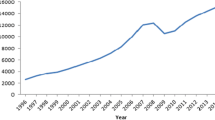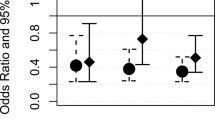Abstract
The aim of this study was to assess the relations between self-rated health (SRH), socioeconomic status (SES), body mass index (BMI) and disability pension. Five birth-year cohorts of middle-aged male residents in Malmö, Sweden, were invited and 5313 with complete data constituted the cohort in this study. Each subject was followed for approximately 11 years. Of all subjects, 73% perceived their health as perfect and among obese men and blue collar workers, the corresponding figures were 67 and 68% respectively. The adjusted odds ratios for SRH less than perfect was 1.3 (CI: 1.1–1.7) for obese subjects and 1.7 (CI: 1.5–1.9) for blue collar workers. The interaction between low SES and obesity was estimated to 11% which was not statistically significant. The adjusted relative risks (RR) of disability pension was 3.3 for subjects with SRH less than perfect, 2.2 for blue collar workers and 2.0 for obese subjects, all statistically significant and only marginally less than the crude RR. Thus, SRH among middle-aged men was associated with obesity as well as low SES, but no evidence of synergism between obesity and low SES in relation to SRH was found. Furthermore, poor SRH in particular, but also low SES and obesity, independently predicted disability pension.
Similar content being viewed by others
References
Mossey JM, Shapiro E. Self-rated health: A predictor of mortality among the elderly. Am J Public Health 1982; 72: 800-808.
Kaplan GA, Camacho T. Perceived health and mortality: A nine-year follow-up of the human population laboratory cohort. Am J Epidemiol 1983; 117: 292-304.
Aro S, Hasan J. Occupational class, psychosocial stress and morbidity. Ann Clin Res 1987; 19: 62-68.
Idler EL, Angel RJ. Self-rated health and mortality in the NHANES-I epidemiologic follow-up study. Am J Public Health 1990; 80: 446-452.
Wannamethee G, Shaper AG. Self-assessment of health status and mortality in middle-aged British men. Int J Epidemiol 1991; 20: 239-245.
Barsky AJ, Cleary PD, Klerman GL. Determinants of perceived health status of medical outpatients. Soc Sci Med 1992; 34: 1147-1154.
Bue-Bjorner J, Søndergaard-Kristensen T, Orth-Gomér K, Tibblin G, Sullivan M, Westerholm P. Self rated health — a useful concept in research, prevention and clinical medicine. Uppsala: Swedish Council for Planning and Coordination of Research (Forskningsrådsnämnden), 1996.
Møller L, Kristensen TS, Hollnagel H. Self-rated health as a predictor of coronary heart disease in Copenhagen, Denmark. J Epidemiol Community Health 1996; 50: 423-428.
Idler EL, Benyamini Y. Self-rated health and mortality: A review of twenty-seven community studies. J Health Soc Behav 1997; 38: 21-37.
Sundquist J, Johansson S-E. Self reported poor health and low educational level predictors for mortality: A population based follow up study of 39,156 people in Sweden. J Epidemiol Community Health 1997; 51: 35-40.
Miilunpalo S, Vuori I, Oja P, Pasanen M, Urponen H. Self-rated health status as a health measure: The predictive value of self-reported health status on the use of physician services and on mortality in the working-age population. J Clin Epidemiol 1997; 50: 517-528.
Idler EL, Kasl SV. Self ratings of health: Do they also predict change in functional ability? J Gerontology — Ser B, Psychol Sci Social Sci 1995; 50: 344-353.
Kennedy BP, Kawachi I, Glass R, Prothrow-Stith D. Income distribution, socioeconomic status, and self rated health in the United States: Multilevel analysis. Br Med J 1998; 317: 917-921.
Harlan WR, Landis JR, Flegal KM, Davis CS, Miller ME. Secular trends in body mass in the United States, 1960–1980. Am J Epidemiol 1988; 128: 1065-1074.
Kuskowska-Wolk A, Bergstöm R. Trends in body mass index and prevalence of obesity in Swedish men 1980–89. J Epidemiol Community Health 1993; 47: 103-108.
Stunkard AJ. Socioeconomic status and obesity. Ciba Found Symp 1996; 201: 174-182.
Sullivan M, Karlsson J, Sjöström L, Backman L, Bengtsson C, Bouchard C, et al. Swedish obese subjects (SOS) — an intervention study of obesity. Baseline evaluation of health and psychosocial functioning in the first 1743 subjects examined. Int J Obes Relat Metab Disord 1993; 17: 503-512.
Ferraro KF, Yu Y. Body weight and self-rating of health. J Health Soc Behav 1995; 36: 274-284.
Månsson N-O, Eriksson K-F, Israelsson B, Ranstam J, McLander A, Råstam L. Body mass index and disability pension in middle-aged men — non-linear relations. Int J Epidemiol 1996; 25: 80-85.
Shaper AG, Wannamethe SG, Walker M. Body weight: Implications for the prevention of coronary heart disease, stroke and diabetes mellitus in a cohort study of middle aged men. Br Med J 1997; 314: 1311-1317.
Allison DB, Faith MS, Heo M, Kotler DP. Hypothesis concerning the U-shaped relation between body mass index and mortality. Am J Epidemiol 1997; 146: 339-349.
Haglund BJA. Geographical and socioeconomic distribution of overweight and morbidity in a rural Swedish county. Scand J Soc Med 1987; 15: 19-29.
Sobal J. Obesity and socioeconomic status: A framework for examining relationships between physical and social variables. Med Anthropol 1991; 13: 231-247.
Gortmaker SL, Must A, Perrin JM, Sobol AM, Dietz WH. Social and economic consequences of overweight in adolescence and young adulthood. N Engl J Med 1993; 329: 1008-1012.
Gutiérrez-Fisac JL, Regidor E, Rodríguez C. Economic and social factors associated with body mass index and obesity in the Spanish population aged 20–64 years. Eur J Public Health 1995; 5: 193-198.
Seidell JC, Flegal KM. Assessing obesity: Classification and epidemiology. Br Med Bull 1997; 53: 238-252.
Trell E. Community-based preventive medical department for individual risk factor assessment and intervention in an urban population. Prev Med 1983; 12: 397-402.
Månsson N-O, Råstam L, Eriksson K-F, Israelsson B, Melander A. Incidence of and reasons for disability pension in a Swedish cohort of middle-aged men. Eur J Public Health 1994; 4: 22-26.
Bray GA. Definition, measurement and classification of the syndromes of obesity. Int J Obes 1978; 2: 99-112.
Statistics Sweden. Ohälsa och sjukvård 1980–1989. (Health and medical care 1980–1989). Rapport nr 76. Örebro: Statistiska centralbyrån, 1992. In Swedish.
National Labour Market Board. Nordisk yrkesklassificering (Nordic Classification of Occupation). 4th ed. Helsingborg: Arbetsmarknadsstyrelsen, 1978. In Swedish.
Statistics Sweden. Folk-och bostadsräkningen 1980 (Population and housing census 1980). Stockholm: Statistiska centralbyrån, 1983. In Swedish.
Kleinbaum DG, Kupper LL, Morgenstern H. Epidemiologic Research. Belmont: Lifetime Learning Publications, 1982.
Rothman KJ. Modern Epidemiology. Boston: Little, Brown & Co, 1986.
Månsson N-O. Disability pension. Epidemiological and financial aspects [Thesis]. Department of Community Medicine, Malmö University Hospital, Lund University, 1997.
Author information
Authors and Affiliations
Rights and permissions
About this article
Cite this article
Månsson, NO., Merlo, J. The relation between self-rated health, socioeconomic status, body mass index and disability pension among middle-aged men. Eur J Epidemiol 17, 65–69 (2001). https://doi.org/10.1023/A:1010906402079
Issue Date:
DOI: https://doi.org/10.1023/A:1010906402079




